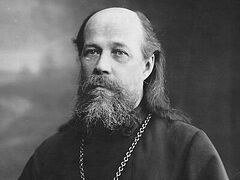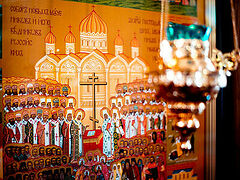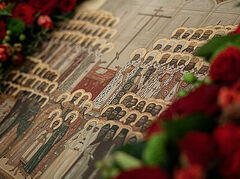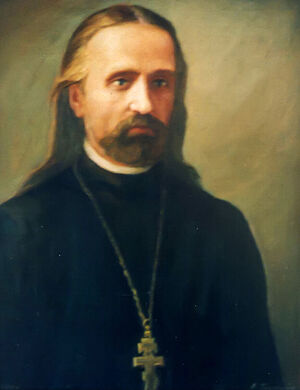 Hieromartyr Vladimir Khirasko On the third Sunday after Pentecost the Russian Orthodox Church honors the memory of the saints of the Belarusian land, including twenty-three New Martyrs of the Diocese of Minsk. Of them we would especially like to remember Hieromartyr Vladimir Khirasko.1 Literally every street in Minsk is in one way or another connected with his ministry.
Hieromartyr Vladimir Khirasko On the third Sunday after Pentecost the Russian Orthodox Church honors the memory of the saints of the Belarusian land, including twenty-three New Martyrs of the Diocese of Minsk. Of them we would especially like to remember Hieromartyr Vladimir Khirasko.1 Literally every street in Minsk is in one way or another connected with his ministry.
Hieromartyr Vladimir was born in 1874 in the city of Kamenets-Podolsky in the Russian Empire’s Podolsky province (now a city in the Khmelnytsky region of Ukraine) to the family of a clergyman Grigory Khirasko. He graduated from the Podolsky Theological Seminary. However, the path of his pastoral ministry began in the village of Omelno in the Minsk province. Later Fr. Vladimir would do much for the then Minsk School for the Blind [which existed from the late nineteenth till the early twentieth centuries.—Ed.] and for many other educational institutions.
The first community for visually impaired and blind parishioners in Minsk, which has existed since 2015, also bears the name of the holy hieromartyr. It has a Braille library and an inclusive “Joy of the Soul” choir, in which many blind singers are involved. And most importantly, here they truly honor and love their heavenly patron and can speak for hours about his life’s path and ministry.
The rector of the Church of Hieromartyr Vladimir in Minsk, Priest Dimitry Vorsa, has shared little-known facts from the life of Archpriest Vladimir Khirasko and his family with us.
***
 Fr. Dimitry Vorsa —Father Dimitry, it sometimes seems to me that even now, just as in his lifetime, Father Vladimir actively loves those in his care…
Fr. Dimitry Vorsa —Father Dimitry, it sometimes seems to me that even now, just as in his lifetime, Father Vladimir actively loves those in his care…
—Yes, he always loved children. And he pastored blind orphans who studied at the School for the Blind. And in this school batiushka sought both to integrate young people into church life and help them learn a profession, so that after leaving the school these boys and girls could provide for themselves and live full lives in society. And he was persecuted for it...
When the 1917 Revolution broke out, the new government sought to close the school. And Father Vladimir understood that if it was done away with, then the boys and girls in his care, especially the orphans, would simply not survive. Batiushka was repeatedly arrested for his opposition to the closure of the school.
—Unfortunately, Father Vladimir was persecuted, and not only for this...
—Unfortunately… From 1915 he was the rector of the Church of the Kazan Icon of the Mother of God, nicknamed “the church of railway workers”, which has not survived. Thousands of... Red Army soldiers would come to listen to his sermons, which bothered the authorities.
 The Church of the Kazan Icon —Perhaps it’s hard to recall everything that he was accused of?
The Church of the Kazan Icon —Perhaps it’s hard to recall everything that he was accused of?
—He was charged with counter-revolutionary activities and agitation. He spent a long time in exile. In 1929, he was sentenced to three years in Siberian labor camps. He was released in 1932, and by that time he had virtually lost his eyesight.
—What is known about the final years of his life?
—After his release he settled in the town of Gzhatsk [now Gagarin in Russia’s Smolensk region.—Ed.]. He served there for several months. And then his life was cut short in unknown circumstances. There is no detailed information about this in the archives, although the archives of that period have survived. As practice shows, this usually means that the person in question was repressed...
—But, despite this, he was not forgotten. After all, he served not only in the School for the Blind...
—He headed several Minsk Orthodox brotherhoods. With sponsorship money these brotherhoods facilitated the development of the city’s educational institutions. Father Vladimir was involved in the opening of the first classical schools (gymnasiums) in Minsk—for boys and for girls. Father Vladimir devoted twenty years of his life to Minsk… It can be said that every street is in some way connected with his ministry.
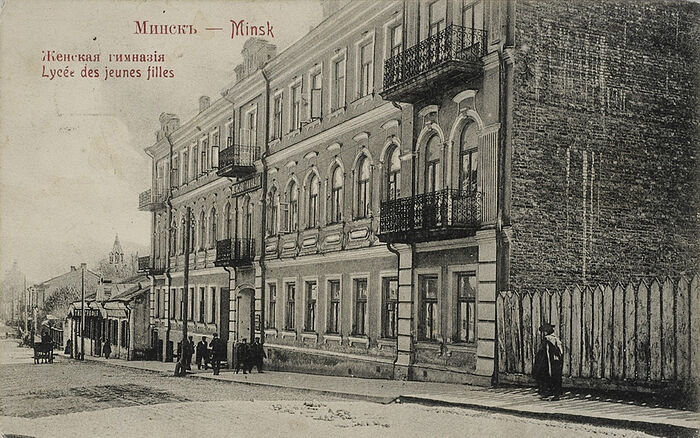 The classical school for girls
The classical school for girls
—And his children occupied worthy places in society...2
—He had five children. And, interestingly, none of his four daughters took her husband's surname. They wanted the surname Khirasko to “live on”. His youngest daughter, Yulia Khirasko (1906-1985), was a ballerina: she finished ballet courses in St. Petersburg (then called Leningrad). She was an amazing person! She was one of the organizers (together with a number of other cultural figures) of the National Opera and Ballet Theater in Minsk.
 Yulia Khirasko, Vladimir Khirasko with family —But to be a daughter of an “anti-Soviet” was very difficult at that time...
Yulia Khirasko, Vladimir Khirasko with family —But to be a daughter of an “anti-Soviet” was very difficult at that time...
—And she didn’t conceal this fact. On the contrary, she often emphasized it. She even mentioned it in her autobiography. She would probably not have escaped the fate of many like her but for her husband, Isidar Balotsin [1907–1961; a singer and public figure.—Ed.], a People's Artist of the Belorusian Soviet Socialist Republic who made every effort to prevent that. But because of this she never received the honorary title of “People’s Artist”. Although her contribution to Belarusian culture cannot be overestimated.
In the post-revolutionary period we did not have enough ballet dancers, and Yulia Vladimirovna invited girls from the neighborhood and began to teach them how to dance, eventually forming a children's ballet troupe from the most gifted. It can be said that this is how the Ballet School was born.
During the Great Patriotic War (1941–1945), Yulia also performed at the front, and after the war she began to run the Ballet School. The ballet “The Nightingale” became a landmark work—she staged ballet dances to Belarusian music. After the production had been shown at the VDNKh (Exhibition of Achievements of National Economy) trade show and amusement park in Moscow, the Opera and Ballet Theater was awarded the title of “Bolshoi”, meaning “Great”. Later, Yulia Vladimirovna received a medal “For Distinguished Labor”.
 Yulia Khirasko —And what about her sisters? They achieved a great deal too, didn’t they?
Yulia Khirasko —And what about her sisters? They achieved a great deal too, didn’t they?
—Father Vladimir’s two eldest daughters, Liubov and Valentina, were teachers. The middle daughter was an architect and had a hand in many important projects, including the design of the Kremlin’s Palace of Congresses on Red Square.
—It was a truly wonderful family…
—Indeed, it was. They did many beautiful and important things. And today, although it may sound pretentious, we have an important task to preserve the memory of such people and strive to follow their example. We believe that with God’s help we will succeed!




